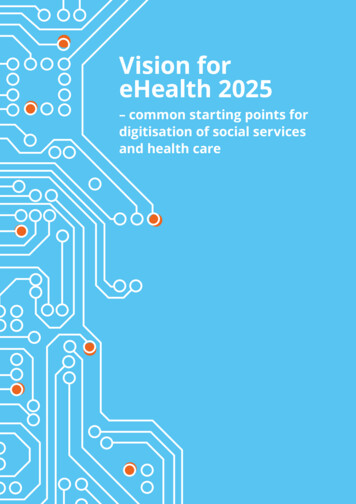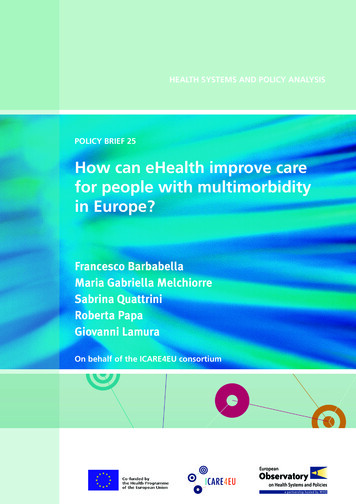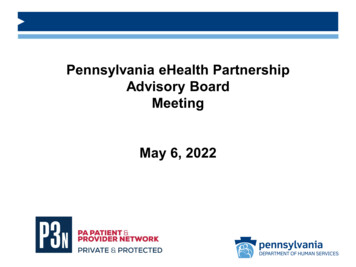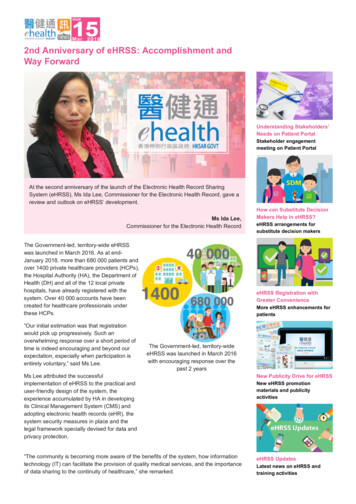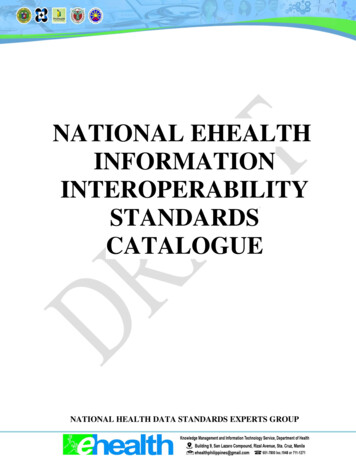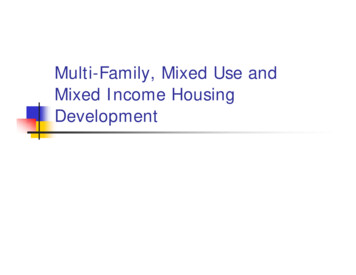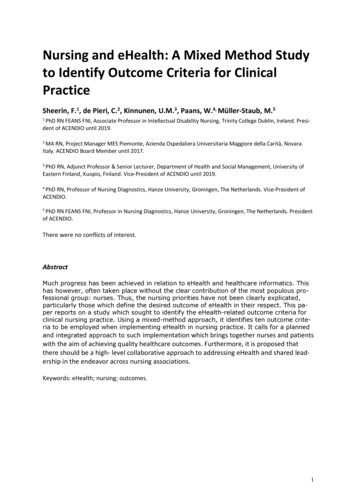
Transcription
Nursing and eHealth: A Mixed Method Studyto Identify Outcome Criteria for ClinicalPracticeSheerin, F.1, de Pieri, C.2, Kinnunen, U.M.3, Paans, W.4, Müller-Staub, M.51PhD RN FEANS FNI, Associate Professor in Intellectual Disability Nursing, Trinity College Dublin, Ireland. President of ACENDIO until 2019.2MA RN, Project Manager MES Piemonte, Azienda Ospedaliera Universitaria Maggiore della Carità, Novara.Italy. ACENDIO Board Member until 2017.3PhD RN, Adjunct Professor & Senior Lecturer, Department of Health and Social Management, University ofEastern Finland, Kuopio, Finland. Vice-President of ACENDIO until 2019.4PhD RN, Professor of Nursing Diagnostics, Hanze University, Groningen, The Netherlands. Vice-President ofACENDIO.5PhD RN FEANS FNI, Professor in Nursing Diagnostics, Hanze University, Groningen, The Netherlands. Presidentof ACENDIO.There were no conflicts of interest.AbstractMuch progress has been achieved in relation to eHealth and healthcare informatics. Thishas however, often taken place without the clear contribution of the most populous professional group: nurses. Thus, the nursing priorities have not been clearly explicated,particularly those which define the desired outcome of eHealth in their respect. This paper reports on a study which sought to identify the eHealth-related outcome criteria forclinical nursing practice. Using a mixed-method approach, it identifies ten outcome criteria to be employed when implementing eHealth in nursing practice. It calls for a plannedand integrated approach to such implementation which brings together nurses and patientswith the aim of achieving quality healthcare outcomes. Furthermore, it is proposed thatthere should be a high- level collaborative approach to addressing eHealth and shared leadership in the endeavor across nursing associations.Keywords: eHealth; nursing; outcomes.1
IntroductionACENDIO (The Association for European Nursing Diagnoses, Interventions and Outcomes) is a European association of nurse experts in the fields of nursing informatics, terminologies and eHealth.ACENDIO’s aim is to promote a common European framework for developing nursing through theimplementation of standardized nursing languages, information systems and eHealth in education,clinical practice and research (Jones et al. 2010). It achieves this aim by conducting conferences, producing publications, supporting nurses and serving as a network and information resource for thenursing community. In response to the development of eHealth across Europe and in Europeanhealth policies, ACENDIO members expressed concerns that the nursing voice is often not heard indiscussions on eHealth and its applications. This concern is supported by Honey et al. (2016). Theyargued that there is a need for exploring the implications of eHealth for nursing. Furthermore, it wasconsidered that research should be undertaken to identify how nursing can work in this emergingcontext and continue to facilitate quality patient outcomes.eHealth is a rapidly developing area which is creating a new and exciting context for the provision ofhealth services and for the practice of nursing. The concept of eHealth is based on the World HealthOrganisation’s definition of health (WHO 2018). The prefix ”e” indicates that electronic, or digitaltechnology can facilitate the achievement of high quality, equal and accessible health care for allmembers of society. According to the WHO (2013), eHealth is defined as the ‘use of information andcommunication technologies (ICT) for health’. (Blumenthal, 2010; United States Department ofHealth & Human Services, 2004). To achieve meaningful use the DHHS released regulations affectinghealth information technology (HealthIT, 2018). The first describes rule-making propositions on howhospitals, physicians, and other health care professionals can qualify for billions of payments throughthe meaningful use of electronic health records (EHRs). The second describes the standards and certification criteria that EHRs must meet in order to produce meaningful eHealth data (Ens4Care, 2015;European Commission, 2012a, 2012b, 2015).BackgroundThe Institute of Medicine (IOM, 2003) identified five core competences needed by all health carepersonal in order to be able to provide high quality care, one of which was utilizing informatics. Theproper use of informatics – now referred to as eHealth - has the potential to support other corecompetences by providing information in a timely manner, functioning as a decision support for quality and facilitating patient involvement. The other core competences are employing evidence-basedpractice, applying quality improvement, working in interdisciplinary teams and providing patientcentered care. The organization, Quality and Safety Education for Nurses (QSEN), expanded thesecompetences to include safety (Cronenwett et al. 2007). Whilst much of the above is derived frommedicine, there are a number of notable nursing sources (Mantas et al. 2010, 2017; Peltonen et al.2016). This has contributed to an historic knowledge deficit within the nurse community regardingeHealth and the use of ICT to support nursing care. Several initiatives have been undertaken to identify what nursing eHealth competences are needed. One such action is the TIGER Initiative (Technology Informatics Guiding Education Reform) (Hübner et al., 2016), a grassroots action aimed at ‘betterpreparing the clinical workforce to use technology and informatics to improve the delivery of patientcare’ (HIMMSS 2018). Other examples of pre-requisite competences have been identified. vanHouwelingen et al. (2016) have identified competences in the domains of knowledge, attitudes, general skills, technological, clinical, communication and implementation. Murphy and Goossen (2017)have concluded that a diverse set of competences and skills are needed to meet the requirements ofnursing in this regard. It is against this backdrop that the current research study was conducted andthat clarity was sought in relation to the position and role of nursing in eHealth.2
Study aimThe aim of the study was to identify categories, sub-categories and outcome criteria related to meaningful and safe use of eHealth from the perspective of expert nurses, as defined by Staggers et al.(2002) and Keeney et al. (2011). Thus, we included ACENDIO-affiliated experts in eHealth who possess a deep understanding of global development, as well as advanced analytic ability in respect ofeHealth and nursing.MethodsDesignA sequential mixed-method design was employed, using a Delphi survey approach and ten international focus groups (Keeney et al. 2010). The Delphi sought to identify ACENDIO experts’ perspectiveson key thematic areas (categories), whereas the subsequent focus groups discussed those themes,reaching a consensus on the constituent sub-categories and outcome criteria. To conclude the study,three verification meetings were held with a reference group of ACENDIO members.SampleAll ACENDIO members (n 165) were invited to take part in the Delphi, 30% (n 48) of whom responded to the survey and contributed to the identification of eHealth categories pertinent to nursing.Focus groups were held in three European countries with a total of 69 nursing terminology and informatics experts participating (table 1). This was a self-selecting convenience sample. Across thethree focus groups, there was engagement with nurses from eleven European countries.Table 1: Details of focus groups conductedData collectionDelphi StudyA three-stage Delphi was employed, the first of which was a scoping, open-ended question to identify the overarching categories pertaining to eHealth in nursing. The second stage sought to explorethe components of those overarching categories (sub-categories) whilst the final stage was employedto validate these sub-categories.Focus GroupsFocus groups were guided by a moderator and assistant moderator, the latter of whom took fieldnotes. Each of the ten focus groups considered specific sub-categories that had been identified during the Delphi study, and was guided by a generic set of questions which sought to uncover the granularity of those sub-categories, in terms of outcome criteria for clinical practice. At the end of eachfocus group session, a report was produced representing a consensus of focus group members’ views3
(Krueger & Casey, 2015). Three additional meetings were led by ACENDIO board members in Reykjavík, Bern and Valencia, the last of which took place in 2017, allowing for consultation and verification of the categories, sub-categories and outcome criteria and affirming the final outcomes of thestudy.Data analysisDescriptive statistics were employed throughout the Delphi process to analyse percentage agreement on content topics. This allowed for the development of consensus on categories and subcategories. Thematic analysis (Hennink et al., 2011) was conducted on data obtained from focusgroups which led to the elucidation of topic areas within those sub-categories.Ethical ConsiderationsThe study was undertaken following approval by the ACENDIO board. Ethical principles were adheredto, including non-maleficience, fidelity, confidentiality and respect for autonomy (Orb et al., 2001).FindingsThe findings of this study are presented in table 2. These set out the categories, sub-categories andoutcome criteria related to the meaningful and safe use of eHealth, and represent the broad thematic areas identified by expert nurses as being pertinent to eHealth in nursing. Furthermore, they pointto competence areas and competence levels for meaningful eHealth understanding and applicationsin nursing.Table 2: Categories, sub-categories and outcome criteria which emerged from the surveys4
The sub-categories identify those components which give focus to the broader categories. These subcategories were ranked by participants, in order of importance, from 1 to 10, where 1 was ‘mostimportant’ and 10 was ‘least important’ item. These are presented in table 3.Table 3: Ranking of subcategories in order of importanceThe outcome criteria, which emerged from the focus group discussions, provide detailed informationon what needs to be achieved in order to progress eHealth in nursing. As such, these signpost thedirection of actions which should be embedded in nursing education and practice.DiscussionThe WHO (2013) definition of eHealth suggests that it is an easily-defined and relatively clearlydescribable field of knowledge. This is, however, not the case as eHealth represents a complex set ofknowledge, competences and values which, in turn, reflect the interpersonal and relational realitiesof health care practice. eHealth is not just about electronically supporting nurses and patients in theachievement of accurate communication and documentation. It also has an important role for informing and guiding practice, as has been demonstrated in the findings of this study.Based on the analysis of the Delphi panel and focus groups, it may be suggested that the forty-twooutcome criteria contain a variety of activities which need to be implemented, in the near future, ifnursing is to ensure that eHealth serves to enhance nursing practice and quality patient outcomes.Although this study has not considered the status of eHealth implementation in healthcare organizations, the authors are aware that eHealth applications have often been poorly implemented in thenursing domain due to the complexity of implementation processes (Black et al. 2011; Abbot et al.2014; Chan et al. 2018; Koivunen and Saranto, 2017). It is acknowledged that the TIGER Initiative hasattempted to redress this situation (Sensmeier et al. 2017), but this has focused mainly on competences which, although a key aspect of implementation, inform only one component of outcomecriteria organized in the sub-categories above. Other components, for example, knowledge-relatedtechnical applications and value-based care quality, need to be addressed as well (Keenan & Yakel,2005; Keenan et al., 2013). Ossebaard and Van Gemert-Pijnen (2016) have noted that successful implementation can only be achieved if there is an integrated and planned approach. As we consider,by way of exemplars, the two most-highly prioritized sub-categories in this study (safety and qualityof care through eHealth technologies, and usability from a nurse’s perspective) we can glean insightsinto the areas which are central to ensuring that a broad implementation can be achieved (Cho et al.,2010).Literature relating to safety and quality of care, in respect of the use of eHealth applications, suggeststhat this area is understudied and that there is scant evidence to inform the validity and reliability ofthose applications and of their ability to achieve quality care (Black et al 2011). In remediating thisshortcoming, the current study has identified criteria that might be employed in ensuring that safetyand quality of care can be achieved. These involve, amongst others, the implementation of securitystandards with clear indicators, as well as standards to prevent data loss.The usability of eHealth technology to support nursing practice and effect quality care is crucial, asdifficulties in this regard may often lead to such technology being disregarded by practicing nurses.This is evident in the poor uptake of, and adherence to eHealth referred to by Ossebaard & van Gemert-Pijnen (2016). This is particularly true in respect of nursing documentation; and despite an internationally consented standard for developing Nursing Process - Decision Support Systems (NP-5
CDSS) was published (Müller-Staub et al. 2016), such systems in EHRs are still scarce. This may berelated to inadequate training/education in the use of these systems, inadequate human-systeminterfaces and that these interfaces may be located at a distance from the situation of patient care.Furthermore, there may be lack of access to an embedded standardized nursing language and/orclinical decision-support within the system (Mitchell et al., 2009; Müller-Staub et al., 2006; Paans etal; 2011). Developments aimed at creating nurse-friendly human interfaces and nursing processclinical decision support systems must be able to offer structured and complete documentation andhandover, based in nursing process-clinical decision-support (Müller-Staub et al. 2016).This discussion has been focused on the consideration of two sub-category areas, as examples ofhow the emergent outcome criteria may inform implementation and, in turn, nursing practice andcare quality. However, in recognition of the limited evidence available to demonstrate that eHealthresults in improved care outcomes (Ossebaard & Van Gemert-Pijnen 2016), it is recommended thateffectiveness studies be conducted to explore the implementation of eHealth based on these and theother outcome criteria identified in this study.ConclusionThis paper has explored the contribution of eHealth to nursing and uncovered the principal areasthat are pertinent, identifying, in particular, the outcome criteria that must be embedded in any successful implementation. Such implementation must be undertaken in a planned, integrated manner,involving nurses and patients in the shared aim of achieving high quality health outcomes. This is inkeeping with Murphy & Goossen’s (2017) perspectives and complements Barton’s (2015) call for astructured set of processes to achieve improved healthcare outcomes, through eHealth. With this inmind, a nursing eHealth agenda could be developed, focusing on the identification and prioritizationof activities, which would lead to the stated outcomes being achieved. Consideration must be givento which nursing entity should take the lead in providing this agenda. It may be that an internationalconsortium of nursing associations could be brought together to support such an initiative.AcknowledgementsKathy Molstad, ACENDIO Board Member and ACENDIO Secretary until 2015.ReferencesAbbott, P., Foster, J., de Fatima Marin, H. and Dykes, P. (2014) Complexity and the science of implementation inhealth IT—Knowledge gaps and future visions. International Journal of Medical Informatics. 83(7), 12-22.Barton, A. (2015) eHealth national priorities. Clinical Nurse Specialist. 29(2), 66–67.Benner, P. (1984). From Novice to Expert: Excellence and Power in Clinical Nursing Practice. Menlo Park: Addison-Wesley.Black, A.D., Car, J., Pagliari, C., Anandan, C., Cresswell, K., et al. (2011) The Impact of eHealth on the Quality andSafety of Health Care: A Systematic Overview. PLOS Medicine 8(1). [Online} Availableat: https://doi.org/10.1371/journal.pmed.1000387 Accessed 7th June 2018.Chan AWK, Tang FWK, Choi KC, Liu T, Taylor-Piliae RE (2018). Clinical learning experiences of nursing studentsusing an innovative clinical partnership model: A non-randomized controlled trial. Nurse education today.2018;68:121-127.Blumenthal, D. (2010). Launching HITECH. The New England Journal of Medicine. 362(5), 382-385.Cho, I., Kim, J., Kim, J. H., Kim, H. Y., and Kim, Y. (2010) Design and implementation of a standards-based interoperable clinical decision support architecture in the context of the Korean EHR. International Journalof Medical Informatics. 79(9), 611-622.Cronenwett, L., Sherwood, G., Barnsteiner, J., Disch, J., Johnson, J., Mitchell, P., Sullivan, D.T. and Warren, J.(2007) Quality and safety education for nurses. Nursing Outlook. 55(3), 122-131.Ens4Care (2015) Evidence based guidelines for nurses and social care workers for the deployment of eHealthservices. [Online] Available at: http://www.ens4care.eu/ Accessed 7th June 2018.6
European Commission (2012a) Innovation in healthcare. [Online] Available tion-in-healthcare-overview-report en.pdf Accessed 7thJune 2018.European Commission (2012b). Communication from the Commission to the European Parliament, the Council,the European Economic and Social Committee and the Committee of the Regions. eHealth Action Plan2012‒2020: Innovative Healthcare for the 21st Century. [Online] Available 1stcentury Accessed 7th June 2018.European Commission (2015) Digital agenda for Europe: A Europe 2020 initiative. [Online] Available europe Accessed 7th June 2018.HealthIT (2018) HealthIT.gov. [Online] Available at: https://www.healthit.gov Accessed 6th June 2018.Hennink, M., Hutter, I. and Bailey, A. (2011) Qualitative Research Methods. Sage Publication, London. P. 243265.HIMMSS (2018) The TIGER initiative. [Online] Available er-initiative Accessed 19th May 2018.Honey, M., Procter, P.M., Wilson, M.L., Moen, A. and Dal Sasso, G.T. (2016) Nursing and eHealth: Are we preparing our future nurses as automatons or informaticians? Studies in Health Technology and Informatics.225, 705-706.Hübner, U., Shaw, T., Thye, J., Egbert, N., Marin, H., and Ball, M. (2016). Towards an international frameworkfor recommendations of core competencies in nursing and inter-professional informatics: The TIGER competency synthesis project. Studies in Health Technology and Informatics. 228, 655-659.Institute of Medicine (2003) Health Professions Education: A Bridge to Quality. Greiner A.C and Knebel, E. Eds.Washington DC: National Academic Press,Jones, D., Lunney, M., Keenan, G., and Moorhead, S. (2010). Standardized nursing languages: essential for thenursing workforce. Annual Review of Nursing Research. 28, 253-294.Keenan, G., and Yakel, E. (2005). Promoting safe nursing care by bringing visibility to the disciplinary aspects ofinterdisciplinary care. AMIA Annual Symposium Proceedings. 385-389.Keenan, G., Yakel, E., Dunn Lopez, K., Tschannen, D., and Ford, Y. B. (2013). Challenges to nurses' efforts ofretrieving, documenting, and communicating patient care information. Journal of the American MedicalInformatics Association. 20(2), 245-251.Keeney, S., McKenna, H., and Hasson, F. (2011). The Delphi Technique in Nursing and Health Research. WestSussex: Wiley-Blackwell.Koivunen, M.and Saranto, K. (2017) Nursing professionals' experiences of the facilitators and barriers to the useof telehealth applications: a systematic review of qualitative studies. Scandanavian Journal of Caring Sciences. 32(1), 24-34.Krueger, R. A., and Casey, M. A. (Eds.). (2015). Focus Groups: A Practical Guide for Applied Research (5edn.).London: Sage.Mantas, J., Ammenwerth, E., Dermis, G., Hasman, A., Haux, R., Hersh, W., , Wright G. (2010) Recommendations of the International Medical Informatics Association (IMIA) on education in biomedical and health informatics. Methods of Information in Medicine. 49(2), 105‒120.Mantas, J., and Hasman. A. (2017) IMIA Educational Recommendations and Nursing Informatics In Judy Murphy, William Goossen, Patrick Weber (Eds.) Forecasting Informatics Competencies for Nurses in the Futureof Connected Health. Studies in Health Technology and Informatics. 232, 20–30.Mitchell, N., Randell, R., Foster, R., Dowding, D., Lattimer, V., Thompson, C., . . . Summers, R. (2009) A nationalsurvey of computerized decision support systems available to nurses in England. Journal of Nursing Management. 17(7), 772-780.Müller-Staub M, Lavin MA, Needham I, van Achterberg T. Nursing diagnoses, interventions and outcomes—application and impact on nursing practice: a systematic literature review. J Adv Nurs. 2006;56(5): 514–531.Müller-Staub, M., de Graaf-Waar, H. and Paans, W. (2016) An internationally consented standard for nursingprocess-clinical decision support systems in electronic health records. Computers, Informatics, Nursing.34(11), 493-592.7
Orb, A., Eisenhauer, L. and Wynaden, D. (2001) Ethics in Qualitative Research. Journal of Nursing Scholarship.33(1), 93-96.Murphy J. and Goossen, W. (2017) Introduction: Forecasting informatics competencies for nurses in the futureof connected health. Studies in Health Technology and Informatics. Vol. 232, 1-6.Ossebaard, H.C., & Van Gemert-Pijnen, L. (2016) Health and quality in health care: implementationtime. International Journal for Quality in Health Care. 28(3), 415-419.Paans W, Nieweg R, van der Schans CP, Sermeus W. What factors influence the prevalence and accuracy ofnursing diagnoses documentation in clinical practice? A systematic literature review. J Clin Nurs.2011;20(17–18): 2386–2403.Peltonen, L.M., Topaz, M., Ronquillo, C., Pruinelli, L., Sarmiento, R.S., Badger, M.K. and Ali, S. (2016) NursingInformatics Research Priorities for the Future: Recommendations from an International Survey. Studies inHealth Technology and Informatics. Vol. 225, 222-226.Sensmeier, J., Anderson, C. and Shaw, T. (2017) International Evolution of TIGER Informatics Competences.Studies in Health Technology and Informatics. Vol. 232, 69-79.United States Department of Health and Human Services. (2004) HHS fact sheet - hit report at a glance: Thedecade of health information technology: Delivering consumer-centric and information-rich health care.[Online] Available from: 1.html Accessed 7th June2018.van Houwelingen, C. Moerman, A. Ettema, R. Kort, H. and ten Cate, O. (2016) Competencies required for nursing telehealth activities: A Delphi-study. Nurse Education Today. 39, 50–62.World Health Organization (2013) Sixty-sixth World Health Assembly: Agenda item 17.5 27 May 2013: eHealthstandardization and interoperability. [Online] Available at:http://apps.who.int/gb/ebwha/pdf files/WHA66/A66 R24-en.pdf?ua 1 Accessed 19th May 2018.World Health Organisation (2018) Constitution of WHO: Principles. [Online] Available at:http://www.who.int/about/mission/en/ Accessed 6th June 2018.8
pean association of nurse experts in the fields of nursing informatics, terminologies and eHealth. ACENDIO's aim is to promote a common European framework for developing nursing through the implementation of standardized nursing languages, information systems and eHealth in education, clinical practice and research (Jones et al. 2010).
